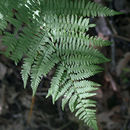More info for the term:
coverCommon ladyfern is found growing in meadows, open thickets, moist woods, and occasionally in swamps [
12]. In West Virginia it occurred in marshy areas where water stood 2 to 4 inches deep (5.0 to 10.2 cm), even in the dry season [
9]. It commonly grows in the understory of western redcedar, western hemlock (Tsuga heterophylla), Douglas-fir (Pseudotsuga menziesii), white spruce (Picea glauca), and black spruce [
4]. It may reach 50 to 100 percent cover under some redcedar stands where seepage maintains high soil moisture [
36]. Elevations at which common ladyfern occurs vary by geographic location as follows: Location Elevation Arizona 7,000 to 9,000 feet (2,134-2,743 m) [
21] California 4,000 to 9,500 feet (1,219-2,896 m) [
26] Idaho 4,100 to 4,300 feet (1,250-1,311 m) [
34] Utah 7,400 to 10,500 feet (2,250-3,200 m) [
38] Vermont 1,600 to 2,200 feet (480-670 m) [
33] West Virginia 1,100 to feet (334 m) [
9] British Columbia 2,950 feet (900) [
7] Ontario 1,000 feet (305 m) [
7]

